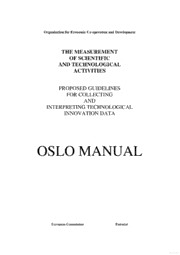Table Of ContentOrganisationforEconomicCo-operationandDevelopment
THEMEASUREMENT
OFSCIENTIFIC
ANDTECHNOLOGICAL
ACTIVITIES
PROPOSEDGUIDELINES
FORCOLLECTING
AND
INTERPRETINGTECHNOLOGICAL
INNOVATIONDATA
OSLO MANUAL
EuropeanCommission Eurostat
31
TABLEOFCONTENTS
Chapter1OBJECTIVESANDSCOPEOFTHEMANUAL 5
21..IFNATCRTOODRUSCITNIFOLNUENCINGTHF.SCOPEOFTHEMANIIAT 55
2.1Understandingtheinnovationprocessandtheimplicationsforinnovationpolicy 6
2.2Experienceonthesupplyside 7
TSCOPEOFTHF.MANTTAT 7
3.1Sectoralcoverage 7
3.3Technologicalproductandprocessinnovation 8
3.4Diffusionofinnovation Q
4.PROVIDINGDATAONTHF.KF.YISSUES 10
4.1FactorsinfluencingTPPinnovation 10
4.2TPPinnovationactivitiesandexpenditures 10
5.4S.O3MThEeSTUPRPViEnnYovIatSiSnUgEfSirmandtheimpactofTPPinnovation 111
5.1Approachtodatacollection 11
6S.T5TA.2HNSEDuArRvREeDyLSAmeTAtINhOoDNdsSRFH.IIPATBFE.PTCWOENECNEPTTHSEOSLOMANUALANDOTHERINTERNATIONA11L22
6.1S&Tactivities:theFrascatifamilyofmanuals 12
6.2Othereconomicnormsandclassifications 1
7.6F.I3NOAtLheRrEreMlaAteRdKconceptsandsurveys 1144
Chapter2NEEDSFORTHEMEASUREMENTOFINNOVATION 15
231...IETNCOTOWRNAOORDMDUISCCTSAIOCOFONNICNENPOTVUAATILOFNRAMEWORK I11S56
3.1Frameworkconditions 20
3.2Scienceandengineeringbase 20
3.3Transferfactors 21
34Innovationdynamo 22
4.PF.CTDTNC1PRIORITIES 25
4.1.Sixareasforinvestigation 25
4.1.1Corporatestrategies 25
4.1.2Theroleofdiffusion „„^25
4.1.3Sourcesofinformationforinnovationandobstaclestoinnovation 26
4.1.4Inputstoinnovation 26
4.1.5Theroleofpublicpolicyinindustrialinnovation 27
1
4.1.6Innovationoutputs 27
4.2Howtomeasureandscopeformeasurement 28
4.2.1“Whatdowewanttomeasure?”:Technologicalproduct&process-TPP-innovations...28
4.2.2"Howshoulditbemeasured?”:Choiceofthesurveyapproach 29
4.2.3“Whereshoulditbemeasured?”:Sectoralcoverage 29
Chapter3BASICDEFINITIONS 31
INTRODUCTION 31
21..MTPAPIINNCNOOMVPAOTNIFO.NNTSOFTPPINNOVATION 3311
2.1Technologicalproductinnovation 31
3.2D.I2FTFeUchSnIoOloNgiOcFalTpPrPocIeNssNOinVnAovTaItOioNnS:INSTITUTIONAT,NOVF.T.TY 3342
3.1Minimumcoverage 34
3.2Coveragewithinthefirm 35
I1.NDDIUSSTTIRNYGUISHINGBETWEENTPPINNOVATIONANDOTHERCHANGESINTill;1IRMO3K6
4.1Organisationalinnovation 36
4.1.2Borderlinecases:organisationalchangeinmanufacturingandserviceprocesses 37
4.2Otherchangesinproductsandprocesses 37
4.2.1Excludinginsignificantornon-novelchanges 37
(a)Ceasingtouseaprocessortomarketaproduct 37
(b)Simplecapitalreplacementorextension 37
(c)Changesresultingpurelyfromchangesinfactorprices 38
(dlCustomproduction 38
(e)Seasonalandothercyclicalchanges 38
(f)Productdifferentiation 38
4.2.2TPPinnovationandothercreativeproductimprovements 39
55..12RTehleatcioomnpwointehntismpalnedmecnotvaetriaogneooffTTPPPPiinnnnoovvaattiioonnsactivities .3490
5.2.1Acquisitionandgenerationofrelevantknowledgenewtothefirm 40
(a)Researchandexperimentaldevelopment 40
(b)Acquisitionofdisembodiedtechnologyandknow-how 40
(c)Acquisitionofembodiedtechnology 40
5.2.2Otherpreparationsforproduction 41
(a)Toolingupandindustrialengineering 41
((bc))OIntdhuesrtrciaaplitdaelsiagcnquni.sei.tcion 4411
(d)Productionstart-up 41
5.2.3Marketingforneworimprovedproducts 41
5.3Borderlinecases 41
5.3.1Design 41
5.3.2Training 42
5.3.3Marketing 42
5.3.4Software 42
76..TTHHEEOTRPPYIANNNDOVPARTACITNIGCFEIRM 4423
2
1
Chapter4INSTITUTIONALCLASSIFICATIONS 44
4231....TTCCOHLLHTFAAEH.SSEAUSSRNIIPTFFPCTIILRSCCAOAASATTSCIIIHOOFNNICBBAYYTIMSOIANZTESNECONOMICACTTVTTY 4444455744
5.1Typeofinstitution 47
5.2Other 47
Chapter5MEASURINGASPECTSOFTHEINNOVATIONPROCESS 49
21..OFBAJCETCOTRISVEASSSOTFSTITNNNOOOVRATHIAOMNPERINGINNOVATION 4590
21Sourcesnfinformationforinnovation 51
2.2Factorshamperinginnovationactivities 52
43..TIDHEENITMIPFYAICNTGOTFPIPNINNONVOAVTAITOINNSGOFNIRTMHSEPERFORMANCEOFTHF.ENTERPRISE 5553
4.1Proportionofsalesduetotechnologicallyneworimprovedproducts 53
4.2Resultsofinnovationeffort 55
4.3ImpactofTPPinnovationontheuseoffactorsofproduction 55
5DI4F.F3.USAIvOeNraOgeFcIoNstNrOeVduAcTtiIoOnsNduetotechnologicalprocessinnovations 555ft
5.1Usersectors 56
5.2Surveysofuseofadvancedtechnologiesinthemanufacturingprocess 56
6.S6.P1ESCpIecAiLalQqUueEsStTioInOsNonSR&D 5577
6.2Questionsonpatentsandtheappropriabilityofinnovations 58
6.3Questionsontheacquisition/diffusionoftechnology 58
Chapter6MEASURINGTHEEXPENDITUREONINNOVATION 60
21..TSHUEGGMEESTTHEODDBORFEAMKEDAOSWUNRSEMENT 6602
2.1Bottom-uportop-downmethod 62
2.2Breakdownhytypeofexpenditure 62
2.2.1TherelationbetweenintangibleinvestmentandTPPinnovationexpenditure 64
2.32.B3r.1eaRkd&oDwnexbpyentdyipteuroefinnovationactivity 6654
2.3.2Expenditurefortheacquisitionofdisembodiedtechnologyandknow-how 65
2.3.3Expenditurefortheacquisitionofembodiedtechnology 65
2.3.4Expenditurefortoolingup,industrialengineering,industrialdesignandproductionstart-up
(includingotherexpenditureforpilotplantsandprototypesnotalreadyincludedinR&D) 65
2JL5ExpenditurefortraininglinkedtoTPPinnovationactivities 66
2.3.6Marketingfortechnologicallyneworimprovedproducts 66
2.4Measurementproblems 66
2.4.1TheborderlinebetweenRft.Oandnon-R&PinnovationexpendiUire 66
2.4.2Otherdifficulties 67
2.5Breakdownbysourceoffunds 68
Chapter7SURVEYPROCEDURES 69
1.POPULATIONS 69
3
2.SURVEYMETHODS 70
2.1Censusorsamplesurvey 70
2.2Mandatoryorvoluntarysurvey 70
2.3Theframepopulation 70
2.4Surveymethodsandsuitablerespondents 71
43.2PE2..SE56TRTIInhFnMeOoAvqRaTuMteIisAOotnNiNoCanOnnEFadiORrReF&ESSDUAsLMuTPrvSTey.-Fs.NSOUNR-VREEYSSPONSF.PROBT.F.M 77773124
56..PFRRFE.SQFU.ENTNACTYTOONFODFARTF.ASICIOTI.T.1S.F.CTION 7765
INTRODUCTION 77
1.S1.U1RIsVsEueYsSadOdNresSsPeEdCbIyFtIhCeIusNeNoOfVoAbjTeIctOaNpSproachdata 7777
1.2.Drawbacksofusingtheobjectapproach 78
1.3Implementationoftheobjectapproach 79
1.4Experienceincollectingdatausingtheobjectapproach 79
1.5Dataitemsamenabletocollectionusingtheobjectapproach 79
1.5.1Descriptivedata 80
1.5.1.1Descriptionofthemaininnovation 80
1.5.1.2Classificationbythetypeofinnovation 80
1.5.1.3Noveltyoftheinnovation 80
a)Classificationbytypeofnoveltyusingtechnicalvariables 80
b)Classificationbytypeofnoveltyintermsofthemarket 80
1S14Nature,ofinnovation SI
1.5.2Quantitativedata 81
1.5.2.1Innovationexpenditure 81
1.5.2.2Impactoftheinnovation 81
1.5.2.3Lifecycleoftheinnovation 81
L5.3Qualitativedata 81
1.5.3.1Benefitsoftheinnovation 81
1.5.3.2Sourcesofinformationorideasfortheinnovation 82
1.5.3.3Diffusionofinnovation 82
alUsersectors 82
1.6.Referenceperiodrelevanttotheobjectapproach 82
2.LITERATURE-BASEDINNOVATIONOUTPUTINDICATORS-LBIO 82
2.1Methodology 83
2.2Strengthsandweaknessesofthemethod 85
ANNEX2THECOLLECTIONOFNON-TKCHNOLOGICALINNOVATIONDATA ...88
21..IWnhtartoduisctiinocnludedinnon-technologicalinnovation? 8888
3.Experienceinthemeasurementofnon-technologicalinnovation 89
4.Whatdatashouldbecollectedonnon-technologicalinnovation? 89
Chapter1
1. OBJECTIVESANDSCOPEOFTHEMANUAL
INTRODUCTION
1. Itisnowacceptedthatthedevelopmentanddiffusionofnewtechnologiesarecentraltothe
growthofoutputandproductivity. Butourunderstandingoftheinnovationprocess,anditseconomic
impact,isstilldeficient. Forexample,weareclearlyinthethroesofamajortechnologicalrevolution,
withtheworldeconomybeingreshapedbynewinformationtechnologiesandbyfundamentalchangein
fieldssuchasbiotechnologyandmaterialsscience. Yettheseradicaltechnologicalshiftsarenotbeing
reflectedinimprovementsintotalfactorproductivityandinoutputgrowthrates.
2. Attemptstounderstandsuchpuzzleshavecometofocus,inrecentyears,onthecritical
importanceofpartsoftheinnovationprocessotherthanR&D,inparticularastheyaffectdiffusionrates.
Theseareareasinwhichwefaceseriousdifficulties,however,inparticularduetotheabsenceofreliable
andsystematicdata.Successinrefiningtheanalysisofinnovation,andintacklingthepolicyproblemsit
poses,willdependinpartontheabilitytoimprovetheinformationavailable.
3. ThefirstversionoftheOsloManual,issuedin1992,andthesurveysundertakenusingit,
notablytheCommunityInnovationSurvey(CIS)organisedbytheEC,showedthatitispossibleto
developandcollectdataonthecomplexanddifferentiatedprocessofinnovation.
4. Thissecondeditionofthemanualtakestheoriginalframeworkofconcepts,definitionsand
methodologyandupdatesthemtoincorporatesurveyexperienceandimprovedunderstandingofthe
cinonmopvaartaibolnepirnoncoevsastiaonndinadliscoattoorstackaenibneadewviedleorperdaningeOoEfCiDndcusoturnitersi.es,Itanpdrodviisdceusssgeusitdheelianneaslybtyicawlhiacnhd
policyproblemstowhichtheindicatorsarerelevant. TheManualhastwoobjectives: toprovidea
frameworkwithinwhichexistingsurveyscanevolvetowardscomparability;andtoassistnewcomersto
thisimportantfield.
5. Theaimofthepresentchapteristogiveanoverviewofthecoverageandcontentsofthemanual
(isnedeicBatoexwh1)y,cseortaasintotyhpeelsposfudcahtanearwecoomrearrsenaontdcootlhleecrtendona-nedxpteortfslaugstehethmeaibnodpyroobflethmestoefxts,etatnidnganlosormtso
toprovidecomparableindicators.
2. FACTORSINFLUENCINGTHESCOPEOFTHEMANUAL
6. How canonedecideontheappropriatescope, structure,terminology andsoonfor
internationallycomparabledatacollection? Thevarietyofsubjectsthatpioneeringandmorerecent
innovationsurveyshavetakeninisevidencethatanextensiverangeofdataispotentiallyavailable.
Obviously,asurveycoveringallthegroundofthesepreviousinvestigationswouldbesocumbersomeas
tobequiteimpracticable.Thatmeansidentifyingpriorities,andselectingthetopics,industriesandsurvey
approachesonwhichtoconcentrate. Thereisalsoaneedtodistinguishbetweendatawhicharebest
collectedonaregularbasis,andmatterswhichcanbetackledmoreeffectivelybyone-offprojects.
5
Box1.Structureofthemanual
Thebodyofthemanualstartswithageneraldiscussionofpointsthatarelikelytohavesome
effectonthechoiceofindicators(Chapter2):
-anadequateconceptualunderstandingofthestructureandcharacteristicsoftheinnovation
processanditsimplicationsforpolicymaking;
-thekeyunresolvedproblemswhichfurtherdatacouldclarify;
-consequencesforthescopeofthemanual.
Itcontinueswithdefinitions,criteriaandclassificationswhicharerelevantforstudiesof
industrialinnovation:
-basicdefinitionsoftechnologicalproduct&process-TPP-innovationandinnovation
activities(Chapter3);
-institutionalclassifications(Chapter4).
Afterthat,suggestionsandrecommendationsareadvancedfornationalandinternationalTPP
innovationsurveys:
-measuringaspectsoftheTPPinnovationprocess(Chapter5);
-measuringtheexpenditureonTPPinnovation(Chapter6);
-innovationsurveyprocedures(Chapter7).
Themanualcloseswithasetofannexesdealingwithtopicswhicheitherofferalternative
procedurestothosegenerallyrecommendedorwhichareofrelevancebutnotsufficientlydevelopedfor
inclusioninthebodyofthemanual:
-the“object”approachtodatacompilation/collection(Annex1);
-thecollectionofnon-technologicalinnovationdata(Annex2).
2.1 Understandingtheinnovationprocessandtheimplicationsforinnovationpolicy
1. Inconstructinginnovationindicatorstheinformationneedsofpolicymakersandanalystsarea
paramountconsideration.Chapter2reviewstheseneeds,whicharepartofthebroadinformationsystem
thathelpstoreduceuncertaintyinpolicymakingandwhichhavebeeninfluenced,evensincethefirst
versionofthismanual,bydevelopmentsintheeconomicsofinnovation.
8. Thusinnovationpolicyhasonlyrecentlyemergedasanamalgamofscienceandtechnology
policyandindustrialpolicy.Itsappearancesignalsagrowingrecognitionthatknowledgeinallitsforms
playsacrucialroleineconomicprogress,thatinnovationisattheheartofthis“knowledge-based
economy”,andalsothatinnovationisamorecomplexandsystemicphenomenonthanwaspreviously
thought.Systemsapproachestoinnovationshiftthefocusofpolicytowardsanemphasisontheinterplays
betweeninstitutions,lookingatinteractiveprocessesbothinthecreationofknowledgeandinitsdiffusion
andapplication.Theterm“NationalInnovationSystem”hasbeencoinedforthissetofinstitutionsand
flowsofknowledge.
9. Forthepurposesofreachingaconceptualframeworkforthepresentmanual,Chapter2centres
onwhatitdescribesas“theinnovationdynamo”ofdynamicfactorsshapinginnovationinfirmswhich
drawonandareinfluencedbytransferfactors,thescienceandengineeringbaseandwiderframework
conditions.
6
10. Chapter2furtherdevelopstheconceptoftheinnovationdynamo,discussingtheeconomic
significanceoftechnologicalchangeandtheassociatedtheories. Asinthepreviousversionofthe
manual,itconcentratesoninnovationatthelevelofthefirmandmoreparticularlytheneo-Schumpeterian
approachandthechain-linkmodelofinnovationwhichviewsinnovationintermsofinteractionbetween
marketopportunitiesandthefirm’sknowledgebaseandcapabilities.However,itisnotthepurposeofthe
discussiontoadheretoanyparticularmodelofinnovationbutrathertoillustratethatinnovationisa
complex,diversifiedactivitywithmanyinteractingcomponents,andthatsourcesofdataneedtoreflect
this.
11. Inconsequenceofthepolicyandanalyticalneedsalreadyexpressed,sixkeyareasforstudyare
identifiedattheendofChapter2:corporatestrategies,theroleofdiffusion,sourcesofinformationfor
innovationandobstaclestoinnovation,inputstoinnovation,theroleofpublicpolicyinindustrial
innovation,andinnovationoutputs.
2.2 Experienceonthesupplyside
12. ThefirsteditionofthemanualwastestedinsurveysinawiderangeofOECDcountries.The
bulkwereundertakenaspartoftheCommunityInnovationSurvey(CIS),whichwasjointlyinitiatedby
EurostatandDGXIII[SPRINTProgramme,EuropeanInnovationMonitoringSystem(EIMS)].Thisused
acommonquestionnairedevelopedfromtheoneappendedtothefirstversionofthismanual.Thirteen
countriesrepresentedbynationalcontractorstookpartintheexercise(Belgium,Denmark,France,
Germany,Greece,Ireland,Italy,Luxembourg,theNetherlands,Norway,Portugal,SpainandtheUnited
Kingdom),whichcoveredtechnologicalinnovationinmanufacturingindustry.Thisexerciseprovideda
widerangeofexperience,astheorganisationsinvolvedintheCIShaddifferentexpertisewhichledtoa
varietyofmethodsandapproaches(seeEvaluationoftheCISSurvey-Phase/,EIMSpublicationn°.ll).
Atthetimeofwriting,pilotstudieswereunderwayonsurveyingtechnologicalinnovationinservices.
13. ThemajorityofotherOECDcountriesalsotestedtheconceptsandclassificationsinthefirst
editionoftheOsloManualinfullorpartialsurveysandwithvaryingdegreesofsuccessforthedifferent
typesofquestions.Hencethissecondversionisbasedonextensivepracticalexperienceofhowfarfirms
areabletounderstandandapplytheconceptsinvolved,ofsurveypracticeandoftheproblemsinvolvedin
compilingandinterpretingtheresultingdata.
3. SCOPEOFTHEMANUAL
14. ForreasonssummarisedattheendofChapter2:
• themanualcoversinnovationinthebusinessenterprisesectoronly;
• itdealswithinnovationatthelevelofthefirm;
• itconcentratesontechnologicalproductandprocess(TPP)innovation,withoptionalguidelinesfor
otherformssuchasorganisationalchange;
• itcoversdiffusionupto“newtothefirm”;
3.1 Sectoralcoverage
15. Innovationcanofcourseoccurinanysectoroftheeconomy,includinggovernmentservices
suchashealthoreducation. Theguidelinesinthismanualareessentiallydesignedtodealwith
7
innovationsinthebusinessenterprisesectorandmoreparticularlyinmanufacturing,construction,utilities
andmarketedservices. TheyhavebeenextensivelytestedformanufacturingbytheCISsurveyand
similarsurveysinotherOECDMembercountries.
16. Innovationinservices,whichwasnotcoveredinthefirstversionofthismanual,iscomplexand
hasspecialcharacteristicswhicharedescribedinChapter2. Sofartherehaveonlybeenindividual,
mainlypilot,surveysofinnovationinservices,andtherecommendationsinthecurrentmanualarebased
onlessfirmgroundthanformanufacturing.
3.2 Innovationatthelevelofthefirm
17. Thismanualdealswithchangeswhichtakeplaceattheleveloftheindividualfirm.Itdoesnot
coversomeothercategoriesofinnovationdiscussedforexamplebySchumpeter,suchastheopeningofa
newmarket,theconquestofanewsourceofsupplyofrawmaterialsorsemi-manufacturedgoods,orthe
re-organisationofanindustry.
18. Forthepurposesofthefirstthreechaptersofthismanualthegenericterm“firm”isused.Itis
givenaspecificstatisticaldefinitioninChapter4,dealingwithclassifications.Exactlywhatdefinitionis
uthseeidrisnubasidsitaurdiyesormasuyrvbeeyomrgaaynihsaevdeinandiifmfepraecnttowanysth.eAresgulitvse.niInnntohveatciaosnemoafymubletiinnattrioodnuacledcocropuonrtartyiobnys
countryormarketbymarket,ormaybeimplementedsimultaneouslythroughoutthegroup.Wherethe
subsidiariesareinfactfranchises,andthusseparateenterprisesforsurveypurposes(oftenthecasein
services),thematterisevenmorecomplicated.
3.3 Technologicalproductandprocessinnovation
19. Afirmcanmakemanytypesofchangesinitsmethodsofwork,itsuseoffactorsofproduction
anditstypesofoutputwhichimproveitsproductivityand/orcommercialperformance. Anexhaustive
studyofsuchchangeswouldbeunwieldyintermsbothofdatacollectionandofsubsequentanalysis.
20. Differentanalyticalapproachescanbeusedtoselectasubsetofthesechangesforfurtherstudy,
forexampleallthoserelatedtothediffusionofinformationtechnologies-IT,orthoseinvolving
intangibleinvestment(R&D,software,training,marketingetc.)(seeSection6below).Thismanualdeals
withchangeswhichinvolveasignificantdegreeofnoveltyforthefirm.Itexcludeschangeswhichare
“moreofthesame”,forexamplethepurchaseoffurthercopiesofITequipmentofamodelalready
installedsomewhereinthefirm.
21. Thebodyofthemanualconcentratesonnewandsignificantlyimprovedproducts(goodsand
services)andprocesses. Itisrecognisedthatpurelyorganisationalinnovationiswidespreadandmay
resultinsignificantimprovementsinfirmperformance.1However,sincetherehasbeenrelativelylittle
practicalexperienceonthistopic,itiscurrentlydealtwithinanannex(Annex2).
22. Themaintextdealswith“technologically”neworimprovedproductsandprocesses. The
meaningofthelabel“technological”,asappliedtoproductsandprocesses,anditsprecisescopein
surveysandstudies,canbeunclear.Thisisparticularlytrueinaninternationalcontext.Itisnotalways
easytodistinguishbetweenthespecialmeaningattributedhere,thedictionarydefinitionsoftheword(or
itsnearestequivalentinsomelanguages)whichmaydiffersubtlybetweencountries,andtheovertonesof
thewordtowhichrespondentsmayreact. Forexample,itwasfeltthatintheserviceindustries
“technological”mightbeunderstoodas“usinghigh-techplantandequipment”.
23. Chapter3proposesdefinitionsbackedupbyexamples. Forthepurposesoftheintroductory
discussioninChapters1and2,aworkingdescriptionofTPPinnovationwillbesufficient.
24. Atechnologicalproductinnovationistheimplementation/commercialisationofaproductwith
improvedperformancecharacteristicssuchastodeliverobjectivelyneworimprovedservicestothe
consumer. Atechnologicalprocessinnovationistheimplementation/adoptionofneworsignificantly
improvedproductionordeliverymethods. Itmayinvolvechangesinequipment,humanresources,
workingmethodsoracombinationofthese.
25. Thedistinctionbetween“technological”noveltyandotherimprovementsrestslargelyonthe
“performancecharacteristics”oftheproductsandprocessesconcerned,anditsapplicabilityinpractice
willdependonthedegreetowhichsuchcharacteristicsandtheirdegreeofnoveltyareanimportantfactor
insalesinthefirm/industryconcerned. Forexample,itiseasiertounderstandandapplytogoodsand
serviceswhicharetradedbetweenfirms,particularlyhigh-techmanufacturingones,thantoconsumer
goodsandservices. Onecanreadilyimagineasetofperformancecharacteristicsforcomputerchips,
computers,papermills,plasticgranulesorevencomputerservicesorcommercialinsurancecover,and
someconventionsatleastaboutwhatconstituted“neworimproved”characteristicswhichwouldbe
comprehensibletobothbuyerandseller.Butwhatarethe“objectiveperformancecharacteristics”ofan
Italian(orChinese)meal,apresentation(orCD)ofAida,aman’snecktie(designer,fake-designer,
chainstore,etc.),apairoftrainers,ajaroffacecreamorabarrelofdomesticsoappowder?Howfardo
consumersbasetheirdecisiontopurchasethemon“performancecharacteristics”?Howfardoproducers
identifynewproductsinthese“technological”terms?
26. Becauseofthelackofcriteriaforansweringthesequestions,technologicalproductinnovation
asdefinedinthismanualexcludeschangesinproductswhichprovidelargelysubjectiveimproved
customersatisfactionbasedonpersonaltasteandaestheticjudgement,and/orderivedfromfollowing
fashions,and/orbroughtaboutlargelybymarketing. However,sincesuchchangesareextremely
importantincertainindustriesandinvolvethesameorsimilaractivitiesasTPPinnovation(design,
marketing,etc.),theyhavebeenseparatelyidentifiedundertheheading“othercreativeproduct
improvements”.
3.4 Diffusionofinnovation
27. DiffusionisthewayinwhichTPPinnovationsspread,throughmarketornon-marketchannels,
from theirfirst worldwide implementation to differentcountries andregions andto different
industries/marketsandfirms. Withoutdiffusion,aTPPinnovationwillhavenoeconomicimpact. In
ordertoincludesomedegreeofdiffusion,asrecommendedinChapter2,theminimumentrytothesystem
describedinthismanualhasbeensetat“newtothefirm”. Thisdecisionmeansthatthecomplete
diffusionofanewtechnologythroughafirmafteritsfirstadoption/commercialisationisnotincluded.
28. However,bycoveringallproductsandprocesseswithperformancecharacteristicswhichare
newtothefirm,theexercisegoeswellbeyondsomeearlierstudieswhichconcentratedonkey
technologiesandtheirinitialintroductionatworldandsometimesnationallevel.
29. Itisalsoproposed(Chapter5)tocollectioninformationfrominnovatingfirmsontheprobable
industryofutilisationoftheirtechnologicallyneworimprovedproducts.Chapter2mentionsalternative
methodsofobtainingdataonthediffusionoftechnology.
9

